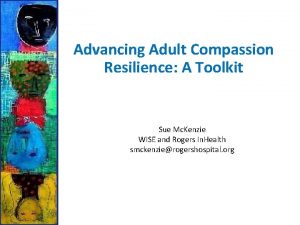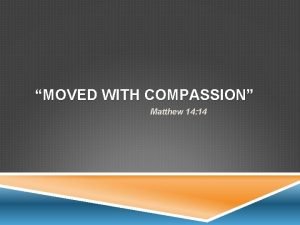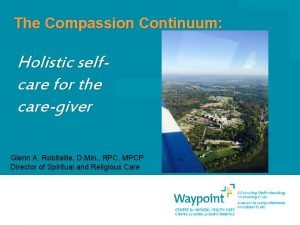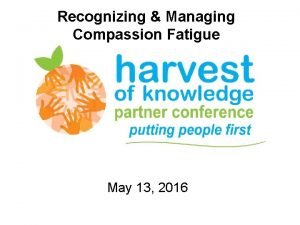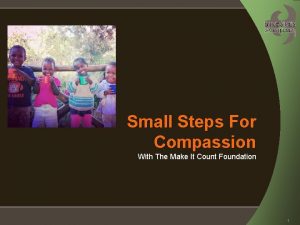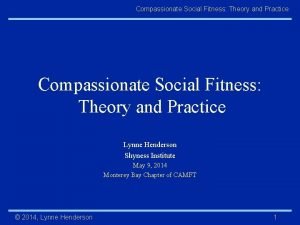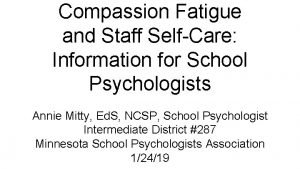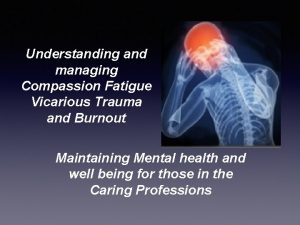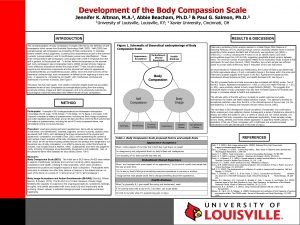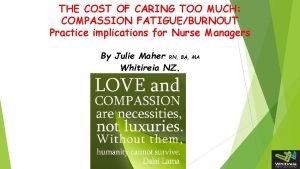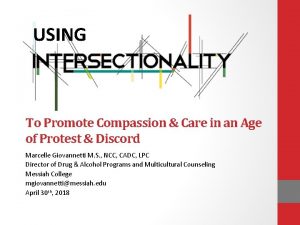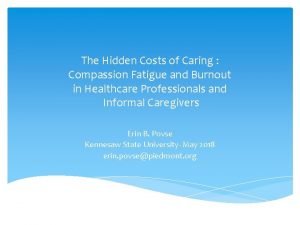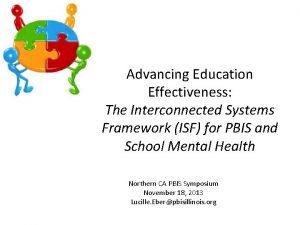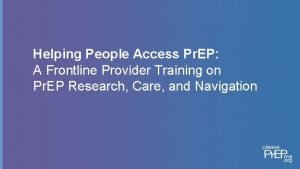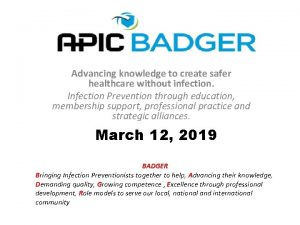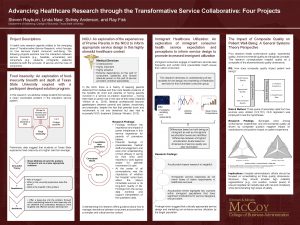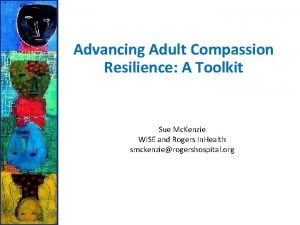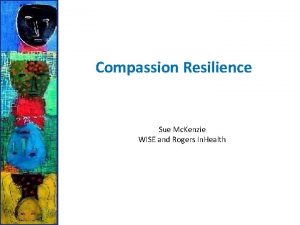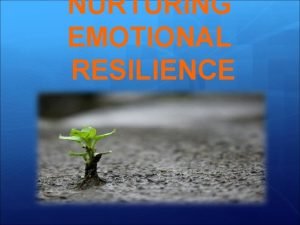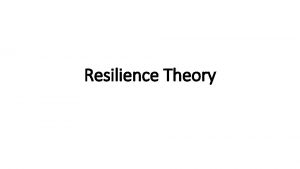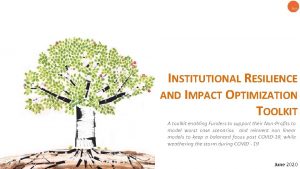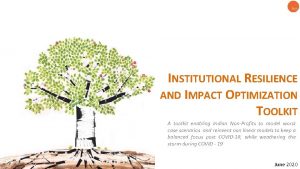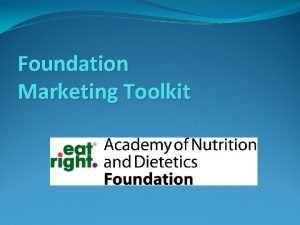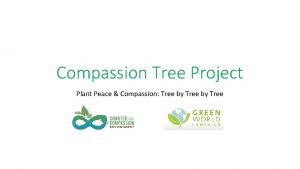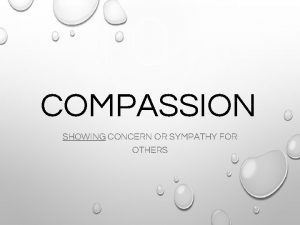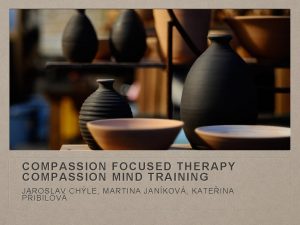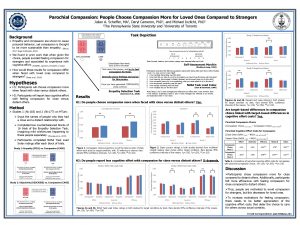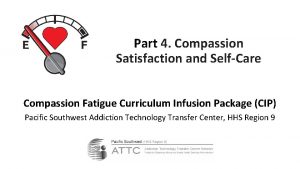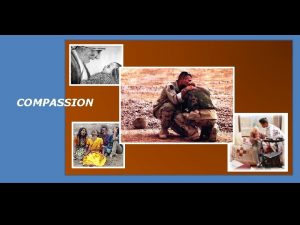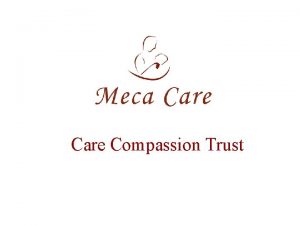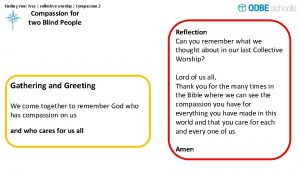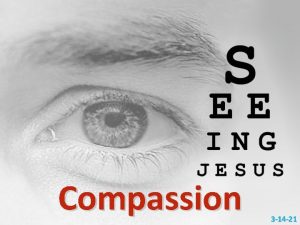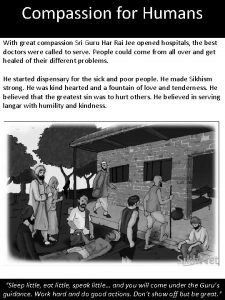Advancing Adult Compassion Resilience A Toolkit Sue Mc












































- Slides: 44

Advancing Adult Compassion Resilience: A Toolkit Sue Mc. Kenzie WISE and Rogers In. Health smckenzie@rogershospital. org

Goals 1. Analyze foundational beliefs about behavior 2. Explore experience of compassion fatigue (individual and team) 3. Learn skills of compassion resilience (individual and team)

How we got to this topic…

Focus Group at Care Connections A stigma-free environment in health care: 1. No fear in my gut when encountering health care professionals about how they will treat me 2. More acceptance of me as a full human, less judgment 3. Labels would be less important 4. Open communication – I would trust them to keep confidentiality and yet l would need it less 5. My physical concerns would be taken seriously and treated no differently than if I did not have a history of mental health challenges 6. Health care professionals would be more approachable

Care Connections (cont. ) 7. Disclosure would not be seen as only my decision- professionals would also consider whether to disclose to me or not 8. Parent and family input would be welcomed, sought and respected 9. Peer support and peer advocates would have a strong voice within the organization 10. Regular collaboration between primary care, psychiatrist, therapist 11. The staff would be more educated about mental illness and recovery- they would know what they are doing 12. Being a less exact science at times and at times, not knowing the science that does exit, care providers would readily admit to not knowing and seek advice from someone who does

Care Connections- Reasons for Stigma 1. Lack knowledge about my condition and feel uncomfortable not knowing 2. Burnout- # of patients, stuck in one way of treatment, close minded 3. They need more time for reflection, peer learning and support, self -care and encounters with people living in recovery 4. COMPASSION FATIGUE!

What do we believe about human behavior?

Observing the two mindsets: Kids/adults/colleagues do well if they want to … 1. 2. 3. 4. Manipulative Just wants attention Not motivated Doesn’t care Kids/adults/colleagues do well if they can … 1. 2. 3. 4. Coping in the way they know how Lack skills required Something in their way Together we can figure it out

“If I really wanted to do something, I would be able to. ” ê self esteem I am not good. ê sense of efficacy I am not able. Avoidance, anger and apathy So, why try! Feelings of Shame

Public stigma- false ideas, beliefs and harmful behaviors ê self esteem I am not good. ê sense of efficacy I am not able. Avoidance, anger and apathy So, why try! Internalized Shame

Stages of Change Theory – what’s needed for change? § Insight § Realistic and relevant hope § Understanding one’s good reasons for unhelpful behavior § Time to let go § Planning and practice (learn what motivates) § Avoidance of triggers § Gradual exposure to triggers § Support for maintenance that includes plan for “refresh” Prochaska and Di. Clementi

Complications of Trauma Prefrontal Lobes Rational thoughts What can I learn from this? Limbic Emotions Am I loved? Brain Stem Survival instinct Am I safe?

The Cycle of Trauma n a c u o Y e h t t p u r r e t in ! e l c cy

Compassion Resilience Outline Content Sections 1. Compassionate Action 2. What Are We Talking About? 3. Compassion Fatigue Awareness, Connection to Trauma, and Assessment 4. Systemic Drivers of Compassion Fatigue 5. Expectations from Self and Others 6. Compassionate Boundary Setting – Personal and Professional 7. Contract for Positive Staff Culture 8. Strategies – Mind 9. Strategies – Spirit 10. Strategies – Strength 11. Strategies - Heart 12. Compassionate Connections with Parents Additional Content Areas Foundational Beliefs about Behavior Dealing with Significant Staff Disclosure or Crisis Supporting Change Efforts of Others and Ourselves Stress throughout the Career Cycle

Section 1: Steps for Compassionate Action Combined from the works of Monica Worline and Jon Katzenbach, Carolin Oelschlegel, and James Thomas 1. Notice – Be present in the moment and able to recognize signs of distress. 2. Self-check - Be aware of your emotional resonance and initial cognitive appraisal. 3. Seek to understand – Suspend appraisals. Listen for understanding. Move towards generous interpretations of another’s behavior. 4. Cultivate compassion – Genuine concern develops based on what you come to understand. This leads to a growing desire/intention to help. 5. Discern best action – Work with the person to figure out what would actually be helpful to them rather than what you think would be helpful or was helpful to you in past, similar circumstances. 6. Take action – Be aware that intention alone is not compassionate action.

Section 2: Key Concepts Compassion Fatigue § Secondary trauma and burnout § Gradual lessening of compassion over time § Avoid trying to understand what people face § Become less effective in our roles § Life satisfaction decreases 16

Building Our Compassion Resilience § The power to return to a position of empathy, strength, and hope after the daily/hourly witnessing of the challenges people face. § To be able to feel optimistic in an imperfect world

Self-Compassion § Extending kindness to ourselves in instances of perceived inadequacy, failure, or our own general suffering. http: //self-compassion. org Kristin Neff

Section 3: Compassion Fatigue § A deeper look at the experience of compassion fatigue § Explore ways to assess ourselves 19

Compassion Fatigue’s Path Leave Profession Zealot We are committed, involved, Compassion Resilience Renewal vs Pathology Overwhelmed, Leaving the profession, Somatic illness, Chronic symptoms or Hardiness, Resiliency, Transformation Zombie and available, Ready to problem solve and to make a difference, We are willing to go the extra mile and often do so Irritability without prompting Anger and cynicism, Diminished creativity, Sadness, Feeling helpless or hopeless Withdrawal A sense that you can’t Inability to embrace complexity, ever do enough, Inflated Chronic exhaustion, Physical sense of importance, illness, Difficulty empathizing, Hyper-vigilance/ Feeling numb to other’s pain, Sleeplessness, Sense of Absenteeism (Cycle is from work of Eric Gentry, Ph. D 2012) persecution

Important Reminder Compassion fatigue is a NORMAL response to ABNORMAL circumstances.

3 Stages of Action to Reduce Compassion Fatigue § Stage 1: Knowledge—Acquisition of information and skills § Stage 2: Recognition—Identification of risk and exposures § Stage 3: Responding—Application of skills Accomplished with supervision, peer support and action ACS-NYU Children’s Trauma Training Institute

Stigma in Healthcare? Nursing staff in emergency departments, inpatient psychiatric settings, and intensive care units in particular, were found to hold blaming/hostile attitudes (when patients were post suicide attempt, suicidal or in psychiatric crises). (Anderson & Standen 2007, Patterson et al. 2007, Thornicroft 2007)

Section 4: System Drivers of Compassion Fatigue

Compassion Fatigue § How are you doing? § Professional Quality of Life Scale (Pro. QOL) • Compassion Satisfaction • Burnout • Secondary Trauma Stress

How does compassion fatigue show up? § In you? § What population or with whom are you most challenged to approach with compassion? § Where do you see it in your organization?

Strategies to Build Compassion Resilience: 1. Realistic expectations of yourself and others – What is enough and what can I hope for? Exposure to recovery! 2. Compassionate boundary setting 3. Culture of connection with colleagues, others in community, and clients’ natural supports 4. Self-care strategies – Mind, Spirit, Strength and Heart

Section 5: Expectations § What positive role do expectations play? § What impact has your unrealistic self-expectations had on your well-being? § What has the impact been of others’ unrealistic expectations of your capacity? § How do you assess if expectations are being set at a helpful aspirational level?

Expectations for People’s Health? § What is my belief about the potential for positive outcomes for people facing complex challenges? § What level of hope do I project in my conversations with others? § How do I assess what is realistic hope?

Expectations: Remind ourselves of the resilience in our clients and colleagues

And then I learned the spiritual journey had nothing to do with being nice. It had to do with being real and authentic. Having boundaries. Honoring and respecting my space first, others second. And in this space of self-care, being nice just happened, it flowed… not motivated by fear, but by LOVE. By Michelle Olak Section 6: Compassionate Boundaries


Tips for Setting Compassionate Boundaries 1. Know what you want to say “Yes” to in your life (values and priorities). 2. Be proactive. Have “meetings” to discuss boundaries. Structure offers safety for both sides. 3. Just say it! Don’t make them guess. Use simple and direct language. 4. Reinforce by pointing out the violations or near violations IN THE MOMENT. 5. Give explanations that are specific, relevant to the other person, and offer shared solutions. 6. Back up your boundary with action. If you give in, you invite people to ignore your needs.

Creating Boundaries Between Experiences § Notice and attend to your own bodily responses and experiences § Make adjustments when transitioning between clients (mind and body) § Process responses NOW LATER

Section 7: Staff Culture - Connect with colleagues and others in the community § Do we have a staff culture agreement? § What are my limitations (my role, skills, current capacity, etc. ) to meet the person’s expressed desires/perceived needs? § What organizations or colleagues can offer services that I cannot? § What is my level of belief in the capacity of others on “my team? ” § What do I need to do to increase my knowledge of and belief in the capacity of others?

Collegial Support and Supervision § Where is your forum for processing intense, sometimes extreme behaviors you encounter? § Does your organization have a structure for confidential and effective identification and management of CF… § That is not crisis-driven? § Who encourages your self-compassion?

A Break for our HEART Commonalities Step 1: “Just like me, this person is seeking happiness in his/her life. ” Step 2: “Just like me, this person is trying to avoid suffering in his/her life. ” Step 3: “Just like me, this person has known sadness, loneliness and despair. ” Step 4: “Just like me, this person is seeking to fill his/her needs. ” Step 5: “Just like me, this person is learning about life. ”

Sections 8 -11: Care for Self

HEART • Relationships: create and maintain healthy connections with others in your life • Emotions: express your emotions and receive others’ emotions in a healthy way MIND • Work: get the most out of educational, volunteer, and employment opportunities • Organization: manage time, priorities, money, and belongings SPIRIT • Core Values: develop a personal value system that supports your sense of meaning and purpose • Rest & Play: balance work and play to renew yourself STRENGTH • Stress Resilience: deal positively with the challenges of life • Care for My Body: build healthy habits around your physical well-being, and to end unhealthy habits

Out of Balance? 1. Avoid Your first clue 2. New perspective 3. Adjust lifestyle Physical Emotional

How do you think about your behavior? A matter of motivation OR A matter of ability and supports

Reversing Shame and Blame When I am Known, Included and Supported ✗ I am good I am able Compassion fatigue I care for myself & others

Next Steps Building My and My Organization’s Capacity for Compassion Resilience • Knowledge – How is this information shared with colleagues? • Recognition – Use of Pro. QOL on a regular basis? • Response – • What expectations need clarified and modified? • How do I regularly expose myself and my colleagues to resilience of those we serve? • What boundaries need to be discussed, re-assessed, reinforced, revised? • What do I need to know about organizational and community resources? • What can I say no to in order to say yes to that which sustains my selfcare balance? What would meaningful support of self-care look like in my organization?

Thank-you for the relationships you build and the strategies you implement that improve the present and future lives of children, adults, parents and staff. WISEwisconsin. org Resilience clips found at: Rogers. In. Health. org Funding for this conference was made possible by NITT-HT grant, CFDA 93. 243 from SAMHSA. The views expressed in written conference materials or publications and by speakers and moderators do not necessarily reflect the official policies of the Department of Health and Human Services; nor does mention of trade names, commercial practices, or organizations imply endorsement by the U. S. Government.
 Compassion resilience toolkit
Compassion resilience toolkit Splagchnizomai
Splagchnizomai Since
Since Compassion fokuseret terapi øvelser
Compassion fokuseret terapi øvelser Compassion focused therapy
Compassion focused therapy Compassion continuum
Compassion continuum Jesus thou art all compassion
Jesus thou art all compassion Forever author of salvation
Forever author of salvation What is compassion fatigue
What is compassion fatigue Everyone needs compassion the kindness of a savior
Everyone needs compassion the kindness of a savior The great gatsby revision
The great gatsby revision Benefits of self compassion
Benefits of self compassion Small steps for compassion
Small steps for compassion Social fitness training
Social fitness training Ted talk compassion fatigue
Ted talk compassion fatigue Self compassion mantra
Self compassion mantra Peter stevenson compassion in world farming
Peter stevenson compassion in world farming Project compassion 2016
Project compassion 2016 Compassion fatigue signs
Compassion fatigue signs Definiton of compassion
Definiton of compassion There is no jew or greek
There is no jew or greek Compassion character trait
Compassion character trait Body compassion scale
Body compassion scale Too much compassion
Too much compassion Compassion care counseling
Compassion care counseling Ofcfbrazil
Ofcfbrazil Advancing vocabulary skills 4th edition
Advancing vocabulary skills 4th edition Advancing colours
Advancing colours Ronald lee in advancing
Ronald lee in advancing 10 steps to improving college reading skills
10 steps to improving college reading skills Advancing of loans
Advancing of loans Advancing education effectiveness
Advancing education effectiveness Advancing technology for humanity
Advancing technology for humanity Advancing vocabulary skills 4th edition
Advancing vocabulary skills 4th edition Advancing vocabulary skills 4th edition
Advancing vocabulary skills 4th edition Ieee advancing technology for humanity
Ieee advancing technology for humanity Gilead advancing access
Gilead advancing access Advancing vocabulary skills 4th edition
Advancing vocabulary skills 4th edition Ten steps to improving college reading skills
Ten steps to improving college reading skills Ten step to advanced reading answers
Ten step to advanced reading answers Advancing knowledge in healthcare
Advancing knowledge in healthcare Learning is like rowing upstream
Learning is like rowing upstream Chapter 11 sentence check 1 clandestine
Chapter 11 sentence check 1 clandestine Advancing healthcare research
Advancing healthcare research Ten steps to advancing college reading skills
Ten steps to advancing college reading skills
